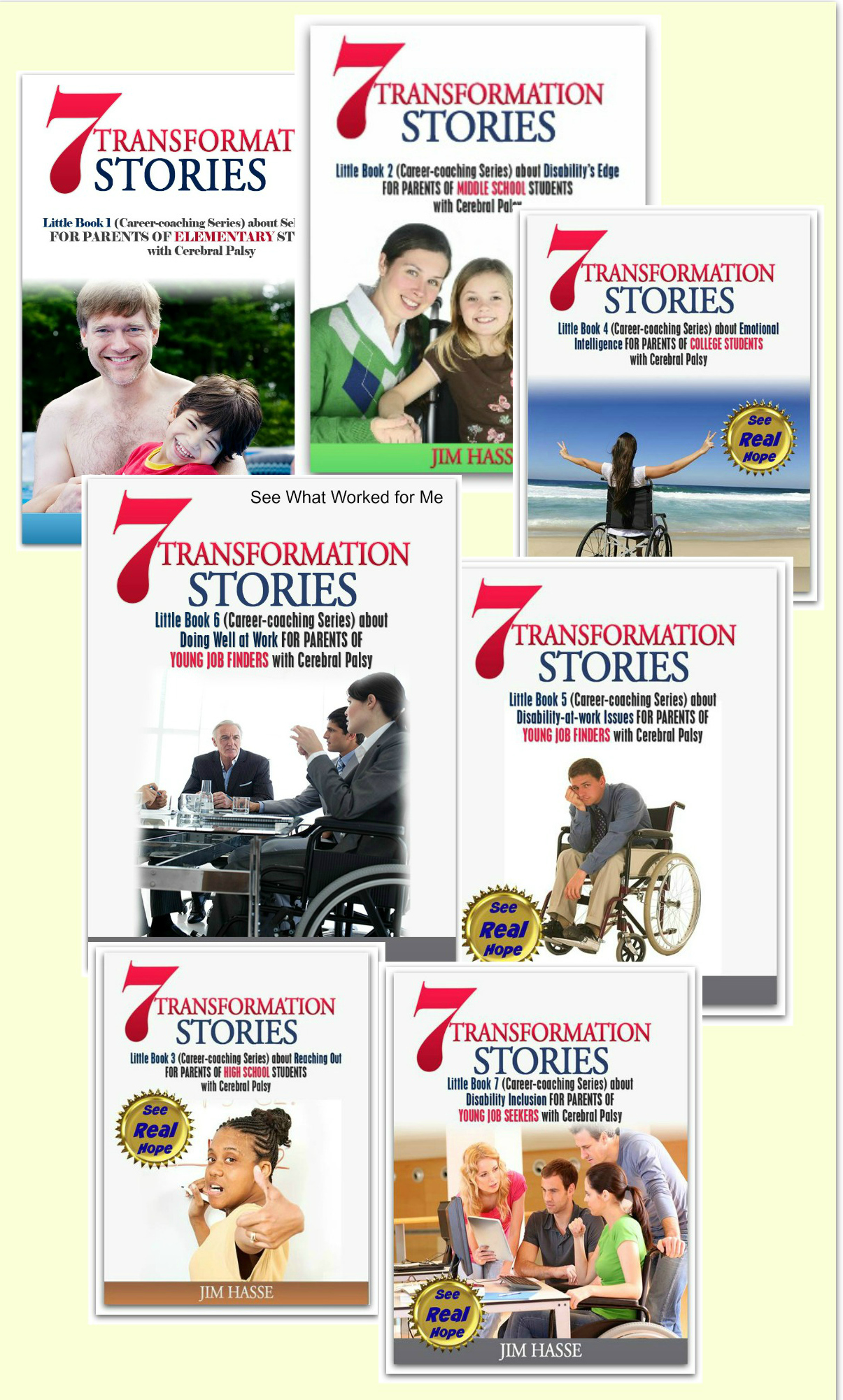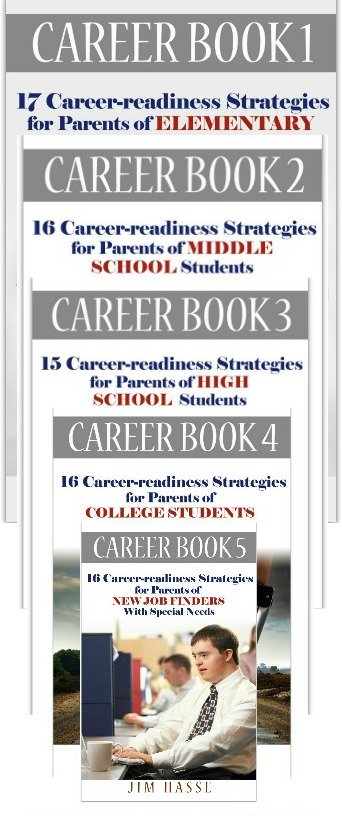Developmental Milestones: Cerebral Palsy Career Builder for Elementary Students
By Jim Hasse, ABC, GCDF, Disability Employment Expert
_________________________________________________________
Reaching three developmental milestones can put your elementary student with cerebral palsy (CP) on a path toward eventually building a rewarding, meaningful career.
Those three developmental milestones are:
- An orientation toward lifelong learning (learning).
- Persistence in working toward a goal (dependability).
- An appreciation for differences in people (acceptance).
Cultivate those three attributes in your youngster now. He or she, as a result, will likely a have the foundation for meeting the needs future employers will seek in job candidates two decades from now.
And the good news is that learning how to live well with CP now can help develop that orientation toward learning, persistence and diversity in your youngster. You can help frame disability as preparation for that future challenge your youngster will face in finding meaningful work. Let me explain.
I’ve identified those three developmental milestones (learning, dependability and acceptance) after listening for two decades to what employees with disabilities say have made them successful and to what employers say they seek in job applicants.
Of course, the attributes employers seek today in applicants they interview for open jobs are different than they were in 1980 and 1990 because the whole work environment has changed and technology has changed. But, the basic needs of employers still remain. They need new employees who know how to learn, are persistent in pursuing a goal and value differences in people.
That’s what V. Scott Solberg, Ph.D., then associate director of Career Development Research at the Center for Education and Work, University of Wisconsin-Madison, also discovered when he interviewed three Wisconsin employers for the center’s Afternoon Tea Conversation Series, a live webcast event.
The panel included these Manitowoc County employers:
- Gary, a corporate trainer representing an energy services company with 240 employees which also manufactures “green” products.
- Becky, a nurse and HR executive for a health care facility which employs 1,300 people in patient and non-patient care.
- John, an owner/operator of a family business which manufactures hydraulic and lubrication components and employs 150 people.
I approached the panel discussion from a disability employment standpoint. I wanted to know what added-value attributes job applicants with disabilities needed to offer a perspective employer that will make them competitive in today’s economy.
This was a wide-ranging discussion, and, after analyzing my notes, I lumped what I thought were the most significant comments from all three panel members under three categories.
Imagine your youngster as a job seeker 20 years from now. Will he or she have reached the required developmental milestones so they can match what these three employers currently seek in a job candidate? Will those attributes still be relevant two decades from now?

Learning
- You are keeping your
skills fresh through continuing education and training.
- You’re dedicated to
lifelong learning; you don’t have all the answers but are willing to (and know
how to) find them.
- You’re open to change, you
continually challenge yourself to improve your skills and you are flexible so
you can be cross-trained laterally as well as vertically; you’ll be able to
learn the job behind you as well as in front of you.
- You’re an innovator and
problem solver and are willing to take a reasonable risk.
- You know information technology.
As a person with a disability, your youngster is going to have a real opportunity to demonstrate his or her ability to learn and to commit to lifelong learning.
If your youngster uses any type of assistive technology (AT) at all, for instance, he or she will have an opportunity to show future employers how keeping up with advances in AT on a yearly basis is work-related experience other job applicants without a disability may not have had. That’s an employment edge your youngster will be able to promote as a job seeker, if you both prepare for it now, together.
Becoming an assistive technology expert – someone who can help an employer easily and economically install any on-the-job accommodations your youngster may need to carry out his or her duties within the workforce of 2030 – is, I believe, one of the key developmental milestones you both can begin to tackle at the elementary school level.
Motivation
- You can demonstrate your
work ethic so your supervisor knows he or she can depend on you.
- You’re dedicated to
doing a good job.
- You’ll take the
initiative.
- You’ll go the extra
mile.
- You truly want the job
at hand.
- You have crystallized your life story and can present it effectively in terms of how it shows you can meet employer needs.
Dependability is the key here. Your elementary school youngster can begin writing personal experience stories (perhaps in an online diary) which show he or she has learned how to live well with CP through persistence (the foundations of dependability).
Then, your youngster will someday be in a position to show how he or she has learned to transfer that persistence to the workplace – an attribute that will increase the resiliency of an employer’s workforce precisely because your youngster has learned how to be persistent and reliable in working toward a goal.
One of the key developmental milestones for your elementary school youngster is developing the reputation for being reliable.
Teamwork
- You are a team player.
- You can be a bridge
between generations within your work group, showing others how to approach work
in ways they have not yet encountered.
- You can work effectively
with a variety of people.
- You’re a good
communicator.
- You’re well-rounded --
you don’t have a 4.0 grade average, and that’s OK because you have participated
in a variety of activities while gaining your education.
- You can handle stress.
As an individual with CP, your youngster will likely find his or herself, at times, with one foot in the non-disabled and the other in disabled world -- and trying to effectively relate to both at the same time. That can be valuable experience.
Over the years, look for opportunities to
show your youngster that he or she can be a bridge builder and be an example to
others about how to value differences in people. Isn't that one of the most important developmental milestones for your youngster?
Think of the differences in generations we have today. Baby boomers approach work from a different perspective than those who are in the generation X category, for example. Employers sometimes have up to four generations represented in their workforces, and they need experienced bridge builders. They need individuals who value (and celebrate) differences in people.
That situation may or may not change in the next 20 years. But, the traditional concept of retirement is fast fading, and the U.S. is becoming a nation of minorities, no longer best described as white, male and Protestant)
So, cultivate your youngster’s bridge building, acceptance experience. It’ll be valuable someday as a job candidate.
What else can you do?
Learning to live well with CP provides your youngster with an array of concrete examples of how he or she has developed many of these 18 personal attributes – developmental milestones which can eventually give him or her the competitive edge as a job candidate -- not in spite of CP but because of it.
Those examples can be powerful during future job interviews, especially if they are very short and always tied to a work setting. Just one timely anecdote can have an impact on an interviewer. There’s no need to overwhelm.
Here’s an imaginary picture your youngster may appreciate. Personal stories are like quivers in a knapsack. Throughout his or her career, your youngster can decide which one is most valuable at the moment, and then use it.
Return from Developmental Milestones to Job
Titles
Go to Cerebral Palsy Career Builders
This is Creative Commons content. You can freely and legally use, share and repurpose it for non-commercial purposes only, provided you attach this sentence and the following attribution to it (including the two links):
Originally written and illustrated by Jim Hasse, ABC, GCDF, owner of Hasse Communication Counseling, LLC, who, as a person with cerebral palsy, served for 10 years as a vice president in a Fortune 500 company during his 29-year career in corporate communication. He’s an Accredited Business Communicator, certified as a Global Career Development Facilitator and author of 14 Amazon books about disability awareness and disability employment issues.





